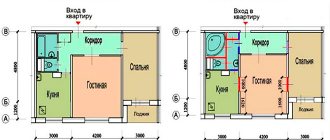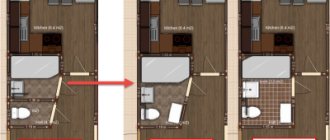Apartment redevelopment
A kitchen combined with a living room is a very rare occurrence, but undoubtedly original.
The process of ordinary furniture rearrangement is quite simple, but the second option has some difficulties and before deciding on it, you need to clearly imagine the upcoming scope of work, the level of costs, as well as the legal consequences.
Moving the kitchen to another room is part of the redevelopment of the apartment.
The kitchen can be moved to the hallway, living room or other room (depending on the features of the house plan). In most cases, kitchens with an area of less than 10 square meters are moved. m. The transfer process is quite complicated both in terms of coordination and implementation, because it is necessary to transfer and connect utilities to existing pipelines, and also take care of ventilation.
Electrical sockets for stoves and other kitchen appliances are in every room, but the sewage system, water supply and ventilation will require a lot of effort and investment.
For example, to ensure gravity flow of sewage, pipes must be laid at a slope. The required slope angle will be quite difficult to achieve when moving the kitchen to distant rooms. In addition, it can be difficult to route sewer pipes without getting into doorways. If, for similar reasons, it is not possible to provide the proper slope, a sewage pump is used. Its use makes it possible to install a sewerage system without a slope. The only drawback is its cost.
How to legalize the transfer of the kitchen to the living room?
We would love to cover the correct procedure for moving the kitchen into the living room, but there is none. Unfortunately, it is impossible to legitimize such redevelopment.
By law, it is prohibited to place a kitchen above the living rooms of neighbors below. This is stated in paragraph 24 of the Decree of the Government of the Russian Federation dated January 26, 2006 No. 47. Moving the wall and expanding the kitchen at the expense of another room will also not work.
The ban does not apply if you live on the first floor or on the second and there are non-residential premises below you, such as a grocery store or restaurant. In this case, you can safely move the kitchen to another room. To do this, you need to submit a redevelopment project and an application to the local housing inspectorate for permission.
But there are nuances.
Firstly, only the sink and stove are reflected in the BTI plans. If you are not going to transfer them, there will be no problems with coordination. The kitchen island and refrigerator can also be placed in the living space. That is, if you want to make a kitchen niche and a large dining room at the expense of the room, such a redevelopment will not violate the law.
Secondly, the stove and sink can be moved to other non-residential premises - a corridor or pantry. But you can’t go into the bathroom or toilet. It is believed that this way you will worsen your living conditions - place the kitchen under the wet area of the neighbors above.
There is also a limitation: the kitchen must have natural lighting. That is, your new kitchen should have a window or light should come from another room, for example through a glass partition.
It turns out that the kitchen can be moved to the hallway or pantry, but not to the bathroom.
It's more difficult with a gas stove. It is almost impossible to move it, because the kitchen with such a stove must be insulated, and the gas pipe must not be routed through the living quarters. And it's dangerous.
It is better not to touch the gas stove at all.
Thirdly, despite the fact that there should not be living spaces under the kitchens, you can enlarge the room at the expense of the kitchen and vice versa. To do this, you need to make the new room uninhabited on paper. In design documentation, such a room can be called an office or living room.
There may be other tricks that designers know about. To do this, we advise you to contact a competent architect to develop a project.
Project approval
Remember that moving a kitchen without project approval is impossible, because it must be reflected in the BTI documents. Even moving the sink within the kitchen requires prior approval from the housing inspector.
If you decide to carry out illegal redevelopment, you may face unpleasant consequences. For example, the neighbors below will complain that you are rattling pots over their bed. Then a housing inspector may come to you with an inspection. She has the right to issue a fine of 2000-2500 R and order the premises to be restored to their previous condition. We will have to break everything and return the kitchen back, otherwise we will face a lawsuit and the sale of the apartment at auction.
In addition, in the future you are unlikely to be able to sell an apartment with illegal redevelopment. The bank will definitely not approve a mortgage for potential buyers.
Non-standard kitchen relocation
Moving the kitchen into the living room has both disadvantages and advantages, but there are obviously more of the latter - space and convenience
Moving the kitchen into the living room, bedroom, hallway or other space is a non-traditional approach.
Non-standard relocation is most acceptable when it is not possible to increase the kitchen area in other ways (use a balcony, if available, or move a wall). This option is quite painstaking both in documentary and technical terms. In addition to obtaining multiple permits, the difficulty lies in relocating utility systems.
A non-standard kitchen relocation is a legal procedure, but not without design difficulties.
In addition, it involves complying with numerous requirements and obtaining the necessary papers.
Non-standard transfer conditions
In order not to get into an unfortunate situation and the work was not in vain, you need to think about the compliance of the redevelopment with the law at the first stage. In order to move the kitchen to another room, you need permission from the organization that is responsible for the redevelopment of residential premises. These documents are developed on the basis of current regulatory documents, which contain many clarifications and prohibitions.
The transfer may become impossible for the following reasons:
- If the comfort of living conditions is disturbed. Previously, no attention was paid to this indicator. In the event of any, even significant, violation, the owner simply signed a paper confirming his consent to these deteriorations. Today this is considered unacceptable.
- In case of violation of the technological instructions of engineering networks. The transfer may not be approved if, when redeveloping the apartment, there is a need to affect the electrical network or water supply system. This point was treated more harshly a few years earlier. The main thing now is that the sites for network redevelopment are freely accessible.
- When connecting rooms whose average temperature differs. Transferring it to a room combined with a balcony is not possible, since it implies changing the heating system to lead it to the balcony. And this is prohibited according to technological standards.
These conventions are the main ones from the entire numerous list of restrictions.
It should be remembered that an illegally redesigned apartment cannot be subject to re-registration.
May or may not be transferred
Let's start with the fact that there are different situations in which transfer is possible and impossible. A few years ago, to redevelop an apartment, all that was required was to write an application to the relevant housing authorities, which quickly approved the construction process. The only stipulation was that the owner himself bears all the risks, and when selling the apartment he notified the buyer about these risks.
For example, to expand the kitchen space, many moved the bathroom partition, making it smaller. That is, the kitchen was at risk of being flooded from the upper floor by sewage. The new rules prohibit doing this, that is, today no one will allow organizing a kitchen space under the wet area of the upper neighbors.
Here are just a few prohibitions on moving the kitchen into the living room or any other room in the apartment.
- You cannot move the kitchen under bathrooms, bathrooms and toilet rooms located on the floor above in apartment buildings. The exception is the top floor or two-level apartment, in which the kitchen is moved to the lower floor.
- You cannot move kitchens into living rooms, since identical rooms on the floor below are classified as “non-residential premises”. The exception is the first or second floor, under which there are no apartments, but, for example, a store or any other consumer service facility.
- You cannot move the kitchen into a room where there is no window opening, and the cooking process itself is carried out on a gas stove. If there are no other options, then the hob will have to be replaced with an electric one. This is the first. Secondly, you will need to think about the room’s ventilation system. Without it, permission for redevelopment cannot be obtained.
Read also: How to design a kitchen in Khrushchev 6 sq m with a refrigerator
Experts note that any transfers and changes are quite large capital investments. But this is not the most important thing. It is very important to correctly approach the implementation of the design of new communication systems. Changing the layout of pipes and other conductors can significantly reduce their efficiency. For example, in order to lengthen or shorten a gas pipe, you will need to obtain permission from the city gas authority. And the reworking of the layout of this pipe will be carried out only by employees of this organization.
In what cases is it possible to move the kitchen into the room? You will definitely be given permission if all household appliances, which include a refrigerator, dishwasher and, of course, a hob, will be located under or above corridors, hallways, built-in closets, and so on. That is, where there are no living rooms. Of course, it is very difficult to plan such a restructuring on your own, so it is recommended to invite a professional designer or architect to do this.
True, the old kitchen space itself, especially in one-room apartments, has small overall dimensions. But it perfectly fits a bedroom or a children's room for one child. But it should be noted that even after receiving permission to move and remodel the old kitchen will still be listed in the documents as a non-residential premises. The exception is the apartment on the top last floor.
There is one more exception: the kitchen can be made residential. It is necessary to indicate in the documents that it will be used as an office. That is, this makes it possible to install furniture in the room.
The presence of natural light in the kitchen is a prerequisite for remodeling an apartment
There is one more strict condition. This is the presence of natural light in the kitchen. That is, even if the new kitchen has lighting and central lighting, the room cannot be used for its intended purpose. Therefore, you will have to think about how natural light can penetrate into the new kitchen. Today several options are used. For example, you can install large glass doors, or build a glass partition instead of a brick one.
Read also: How to properly redevelop an apartment in terms of combining a kitchen and a room
Permissions and prohibitions
If you leave the partition, you can get a great bar
In addition to the stated conditions, there are also certain rules, many points of which, according to current legislation, may not allow the transfer. These prohibitions are justified by separate columns of SNiP and SaNPiNov :
- Moving the kitchen into a living room, which is located according to the building plan above the living area of the neighbors below. The kitchen is a high-water hazard area, as is the bathroom, and in the event of an unexpected flood, the neighbors’ apartment may be damaged.
- The kitchen cannot be moved into the bathroom area. Even if its area is quite sufficient, this is a deterioration of the living conditions itself.
Based on the above conditions and limitations, the conclusion suggests itself that an unconventional kitchen relocation is impossible. However, there are official regulations, as well as a number of tricks that allow you to carry out the transfer:
- There are no transfer restrictions for residents of apartments located on the ground floor.
- Owners of multi-level apartments (excluding the first level) are allowed to move the kitchen, since there is no danger to the living quarters of the neighbors below.
- Moving the kitchen is allowed to a place that is not residential in the apartment below. This could be a hallway or a storage room.
It should be noted that this type of redevelopment is permitted to owners of apartments under which there are shops, offices or cafes. Administrative buildings are not residential, so there are no restrictions for owners of such apartments.
Moving the kitchen to a utility room or bathroom
It is impossible to officially agree on the transfer of the kitchen to the room in apartments on the top floors or duplex apartments. However, in this situation, you can move the kitchen to the bathroom.
In accordance with current building codes, a bathroom and a bathroom cannot be located above kitchens, but in apartments located on the top floors, living conditions will not be worsened as a result of moving the kitchen to the bathroom. Therefore, such a redevelopment can be agreed upon.
In two-level apartments there is a standard layout, the kitchen is usually located on the first “floor”. If you decide to move the kitchen to the bathroom, you should pay attention so that the new kitchen does not overlap with the bathrooms on the second “floor.”
Relocation of household appliances and kitchen electrical equipment
Transferring equipment is not an easy task and has a number of nuances
Appliances and electrical equipment are of great importance when relocating a kitchen. Some government bodies that are involved in the development of permitting documents are loyal to this. If the neighbors' living quarters are located below, the transfer may be allowed provided that water-related items are located on the territory of the non-residential premises of the apartments below.
In a kitchen moved to another room, a gas stove cannot be used, since the gas pipeline can only be installed in the kitchen area, and changing the layout of gas pipes is punishable by law. Only the option of using electric stoves is acceptable.
When using an electric stove for constant cooking, the cost of electricity increases. The use of gas stoves in this regard is more economical.
Relocation of plumbing and communications
Relocating kitchen plumbing and utilities is usually the most lengthy and complex process.
Moving the kitchen to another room will not make sense without moving the sink, which entails changing the water supply and sewerage systems:
- Before redevelopment, a new water supply and sewer plan must be approved.
- New wiring of the water supply and sewer system should be carried out from the closest point, which is located in the kitchen or bathroom.
- Water supply and sewer pipes blocking doorways can be laid under the floor screed. In this case, sewer pipes are laid without a slope using a sewer pump, which is mounted under the sink.
- The plumbing system should be planned taking into account the number of all hot and cold water supply points (sink, washing machine or washing machine).
- To carry out the plumbing system, you can use pipes made of plastic, steel, brass or copper.
- The sewerage system uses pipes with a diameter of at least 50 mm.
Expert advice : when moving the sink to some other place, the mixer itself is often changed, the set of which includes two tubes in a metal braid. When using these pipes, do not allow them to be turned over or twisted sharply, in order to avoid the formation of leaks at load points.
Redevelopment with kitchen relocation
Answer: Moving a kitchen during remodeling involves significant difficulties. If you do not comply with these limits, you will not be able to obtain permission for reconstruction, and if you do it without permission, you will not be able to legalize it. Let us indicate what restrictions exist for such work.
- The kitchen should not be moved to the location of the bathroom or bathroom. The fact is that according to two regulatory documents - SanPiN 2.1.2.2645-10 (clause 3.8) and SNiP 31-03-2003 (clause 9.22) the kitchen should not be located under these rooms. There is no paradox here, since in an apartment building similar rooms are located above each other so that water and sewer lines are on the same line (risers).
- The kitchen cannot be moved to the place of the living room, since it is prohibited to be located above the living area. By moving it this way, you will inevitably be cooking above the living area of your neighbors below.
There is only one reason for such prohibitions: during redevelopment, the water supply and sewerage systems have to be changed, and there is a risk of breaks in these networks above the housing.
- It is prohibited to move the kitchen if this procedure involves moving a gas stove. In such circumstances, it will not even be possible to obtain permission, and if you take independent action, very severe sanctions will follow. You can make some progress if you replace the gas stove with an electric one.
- The kitchen ventilation system should be arranged separately from the ventilation of the bathroom and bathroom. When transferred, this requirement may result in significant difficulties, and if they cannot be resolved, then permission may not be obtained.
There is only one rational solution: to move the kitchen to the place of the corridor, pantry or other non-residential premises. In this case, if something happens, the neighbors’ living rooms will not be affected.
However, you should not despair and you need to prepare a sketch of the redevelopment and visit the housing inspection. There you should consult with specialists whether you will be able to realize your intentions in your conditions.
If you receive preliminary approval, you can begin the final approval process.
The entire approval mechanism is described in detail in the material “Redevelopment - how to obtain permission, step-by-step instructions.”
And under no circumstances begin such a restructuring without the prior consent of the supervisory authorities. Even through the court, it will not be possible to achieve a positive decision for you, since fundamental construction and sanitation standards are violated.
Room ventilation
Proper ventilation will help maintain the necessary humidity in the kitchen.
There are special conditions for ventilation of the room into which the kitchen is planned to be moved:
- The air ventilation of the new kitchen should pass through the duct of the old room. This entails pulling the ventilation duct through all the rooms in the path.
- Air from the relocated kitchen should not penetrate through the ventilation ducts to the neighbors.
- It is prohibited to connect ventilation ducts to bathroom ducts.
- If the length of the ventilation duct is large enough, it is necessary to additionally install fans that stimulate natural draft.
Advice : if it is necessary to conduct a ventilation duct through living spaces, stretch or multi-level ceilings will help. However, a permit is required to make holes in load-bearing walls.









